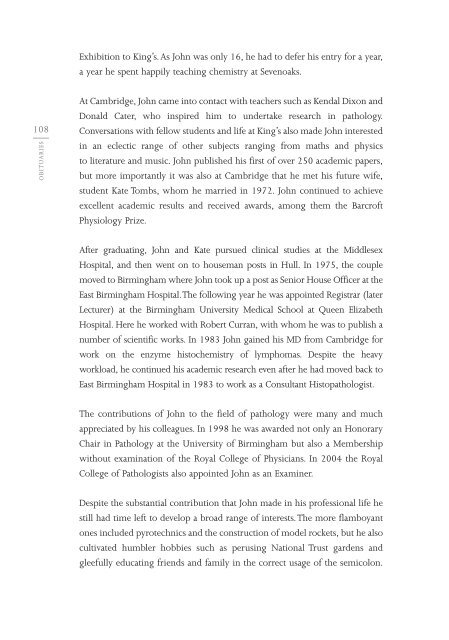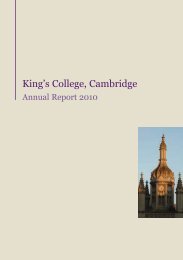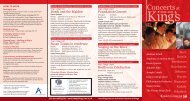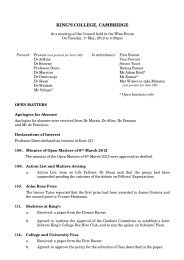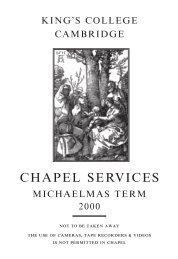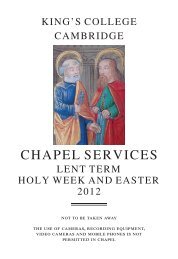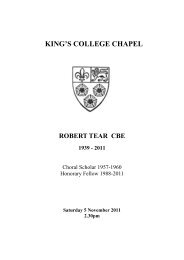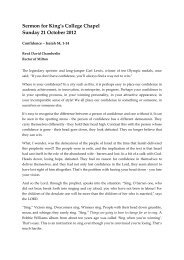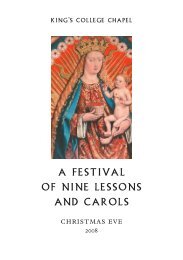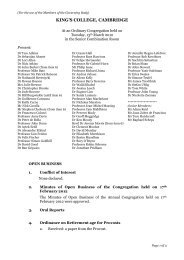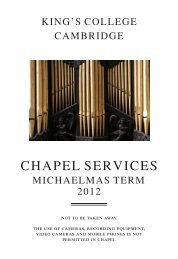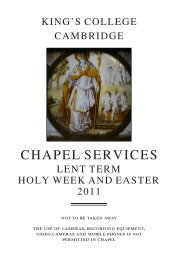Part 2 (Obituaries) - King's College - University of Cambridge
Part 2 (Obituaries) - King's College - University of Cambridge
Part 2 (Obituaries) - King's College - University of Cambridge
You also want an ePaper? Increase the reach of your titles
YUMPU automatically turns print PDFs into web optimized ePapers that Google loves.
108<br />
OBITUARIES<br />
Exhibition to King’s.As John was only 16, he had to defer his entry for a year,<br />
a year he spent happily teaching chemistry at Sevenoaks.<br />
At <strong>Cambridge</strong>, John came into contact with teachers such as Kendal Dixon and<br />
Donald Cater, who inspired him to undertake research in pathology.<br />
Conversations with fellow students and life at King’s also made John interested<br />
in an eclectic range <strong>of</strong> other subjects ranging from maths and physics<br />
to literature and music. John published his first <strong>of</strong> over 250 academic papers,<br />
but more importantly it was also at <strong>Cambridge</strong> that he met his future wife,<br />
student Kate Tombs, whom he married in 1972. John continued to achieve<br />
excellent academic results and received awards, among them the Barcr<strong>of</strong>t<br />
Physiology Prize.<br />
After graduating, John and Kate pursued clinical studies at the Middlesex<br />
Hospital, and then went on to houseman posts in Hull. In 1975, the couple<br />
moved to Birmingham where John took up a post as Senior House Officer at the<br />
East Birmingham Hospital.The following year he was appointed Registrar (later<br />
Lecturer) at the Birmingham <strong>University</strong> Medical School at Queen Elizabeth<br />
Hospital. Here he worked with Robert Curran, with whom he was to publish a<br />
number <strong>of</strong> scientific works. In 1983 John gained his MD from <strong>Cambridge</strong> for<br />
work on the enzyme histochemistry <strong>of</strong> lymphomas. Despite the heavy<br />
workload, he continued his academic research even after he had moved back to<br />
East Birmingham Hospital in 1983 to work as a Consultant Histopathologist.<br />
The contributions <strong>of</strong> John to the field <strong>of</strong> pathology were many and much<br />
appreciated by his colleagues. In 1998 he was awarded not only an Honorary<br />
Chair in Pathology at the <strong>University</strong> <strong>of</strong> Birmingham but also a Membership<br />
without examination <strong>of</strong> the Royal <strong>College</strong> <strong>of</strong> Physicians. In 2004 the Royal<br />
<strong>College</strong> <strong>of</strong> Pathologists also appointed John as an Examiner.<br />
Despite the substantial contribution that John made in his pr<strong>of</strong>essional life he<br />
still had time left to develop a broad range <strong>of</strong> interests.The more flamboyant<br />
ones included pyrotechnics and the construction <strong>of</strong> model rockets, but he also<br />
cultivated humbler hobbies such as perusing National Trust gardens and<br />
gleefully educating friends and family in the correct usage <strong>of</strong> the semicolon.


